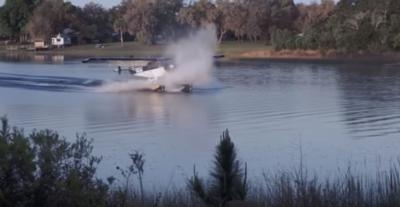Sat, Jun 18, 2016
Allows Piston Aircraft To Have Full Reversing Function Similar To Turboprop Airplanes
The FAA has granted an STC to Flight Resource, a distributers of MT Composite propellers, for the reversing option for the MT Composite two or three blade propeller for Cessna aircraft.

This unique, technologically advanced system utilizes a two stage hydraulic governor and a dual piston propeller hub to allow a piston engine aircraft to have a full function reversing option similar to that found in turboprop airplanes.
Flight Resource’s Cessna STC approves the installation of the 83” two or three blade MT Composite propeller to all Cessna 180/182/185/(T)206/(T)207/(T)210 aircraft with any version of TCM -470, -520 or -550 engines. The MT reverse system allows for significantly enhanced maneuvering of seaplanes never before possible and effective braking for ski planes. The MT reversing system also greatly reduces the landing distance of aircraft, especially on wet, icy or slippery surfaces. The reversing option adds about $10,000 to the price of the prop kit.
There are several safety features to the MT Reverse system assure the reverse is only activated when required for ground operations:
- The system incorporates a static system pitot switch that will de-activate the system above a chosen indicated airspeed to prevent accidental activation in flight.
- The system will not activate above 1300 rpm as the dual pistons lock together and reverse cannot be selected.
- The system has a reverse “active” warning light to inform the pilot the reverse has been activated.
- The system activation requires the master reverse power switch be turned on and the momentary reverse switch to be selected to enable the reverse.
“The MT composite props are perfect for seaplane use," said Larry Schlasinger, Technical Specialist at Flight Resource. "A nickel leading edge eliminates blade erosion and the natural composite core. Constructed with several layers of carbon fiber cloth, the prop is stronger than metal, yet up to 30 pounds lighter. Additionally, the natural composite core absorbs engine vibration making it feel like you are powered by a turbine”.
(Source: Flight Resource news release. Image from Flight Resource YouTube video)
More News
Light Gun A handheld directional light signaling device which emits a brilliant narrow beam of white, green, or red light as selected by the tower controller. The color and type of>[...]
"The journey to this achievement started nearly a decade ago when a freshly commissioned Gentry, driven by a fascination with new technologies and a desire to contribute significan>[...]
Aero Linx: JAARS, Inc. For decades now, we’ve landed planes on narrow rivers and towering mountains. We’ve outfitted boats and vehicles to reach villages that rarely se>[...]
"Our driven and innovative team of military and civilian Airmen delivers combat power daily, ensuring our nation is ready today and tomorrow." Source: General Duke Richardson, AFMC>[...]
Aircraft Conflict Predicted conflict, within EDST of two aircraft, or between aircraft and airspace. A Red alert is used for conflicts when the predicted minimum separation is 5 na>[...]
 ANN's Daily Aero-Term (04.20.24): Light Gun
ANN's Daily Aero-Term (04.20.24): Light Gun Aero-News: Quote of the Day (04.20.24)
Aero-News: Quote of the Day (04.20.24) ANN's Daily Aero-Linx (04.21.24)
ANN's Daily Aero-Linx (04.21.24) Aero-News: Quote of the Day (04.21.24)
Aero-News: Quote of the Day (04.21.24) ANN's Daily Aero-Term (04.21.24): Aircraft Conflict
ANN's Daily Aero-Term (04.21.24): Aircraft Conflict



